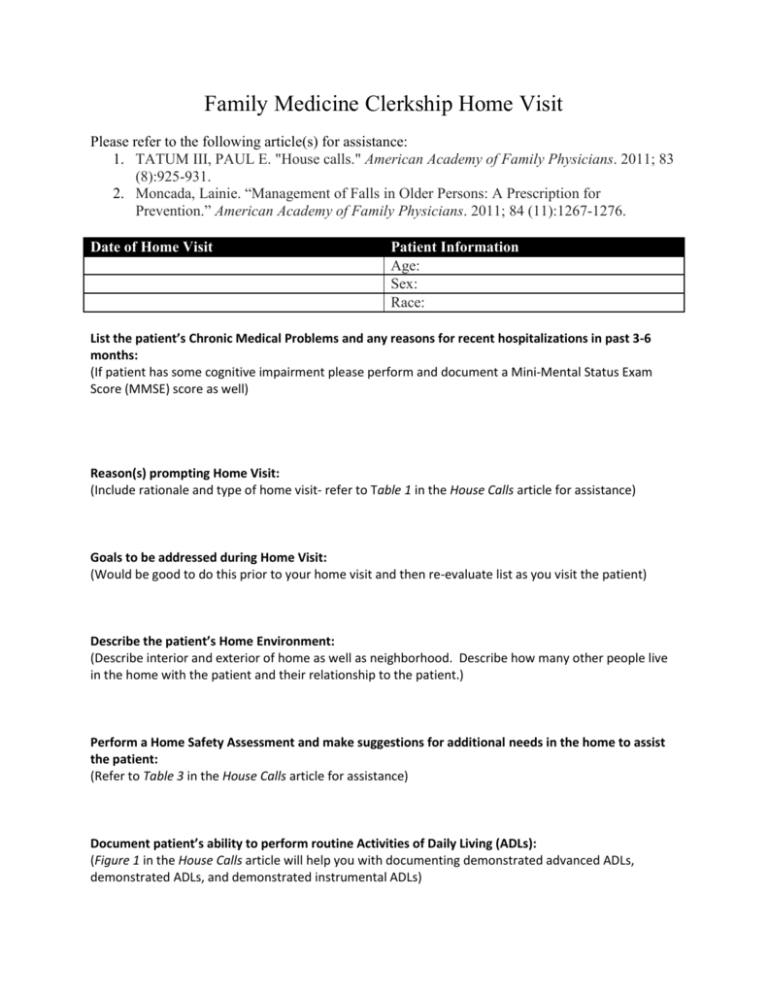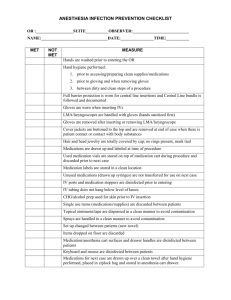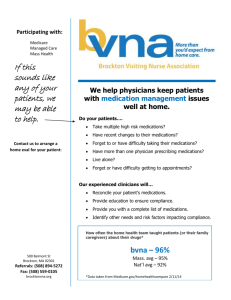Home Visit
advertisement

Family Medicine Clerkship Home Visit Please refer to the following article(s) for assistance: 1. TATUM III, PAUL E. "House calls." American Academy of Family Physicians. 2011; 83 (8):925-931. 2. Moncada, Lainie. “Management of Falls in Older Persons: A Prescription for Prevention.” American Academy of Family Physicians. 2011; 84 (11):1267-1276. Date of Home Visit Patient Information Age: Sex: Race: List the patient’s Chronic Medical Problems and any reasons for recent hospitalizations in past 3-6 months: (If patient has some cognitive impairment please perform and document a Mini-Mental Status Exam Score (MMSE) score as well) Reason(s) prompting Home Visit: (Include rationale and type of home visit- refer to Table 1 in the House Calls article for assistance) Goals to be addressed during Home Visit: (Would be good to do this prior to your home visit and then re-evaluate list as you visit the patient) Describe the patient’s Home Environment: (Describe interior and exterior of home as well as neighborhood. Describe how many other people live in the home with the patient and their relationship to the patient.) Perform a Home Safety Assessment and make suggestions for additional needs in the home to assist the patient: (Refer to Table 3 in the House Calls article for assistance) Document patient’s ability to perform routine Activities of Daily Living (ADLs): (Figure 1 in the House Calls article will help you with documenting demonstrated advanced ADLs, demonstrated ADLs, and demonstrated instrumental ADLs) Evaluate patient’s impairments in mobility and fall risk (if applicable): (Look into balance and gait issues as well as sensory impairment; if possible and safe use the get up and go test if patient has a history of falls to asses fall risk and document ways to help reduce fall risk in this patient- use the Management of Falls in Older Persons: A Prescription for Prevention Article to assist you with this) Evaluate the patient’s nutritional status: (Refer to Figure 1 in the House Calls article for assistance) Describe the impact of the patient’s chronic medical problems on the patient and their family (emotional, psychological, and economic): Perform the Home Visit Medication Reconciliation Exercise: (See last page for full details of documentation) Document patient’s current sources (if any) of health care, community and family support: (Caregivers in the home, family close by to assist, home health support, and home PT/OT support? Meals on wheels? Senior Citizen Center?) Identify any other resources in the community or that could be provided by their primary care physician in way of referrals this patient could use: How did this home visit impact your future care of this patient or similar patients you may encounter during your clinical care? Home Visit Medication History Exercise Please address these therapeutic issues as part of the documentation of your home visit. 1. Document the patient’s allergies to medications and the reaction caused by that medication a. Example: Penicillin- caused hives 2. Complete list of prescription and over-the-counter medications the patient is taking with the dosages, frequency, route of administration, indication for each drug, and other clinics patient getting medication from (cardiology vs. family medicine vs. nephrology etc.) a. Example: Hydrochlorothiazide 25mg tablet by mouth once daily for Hypertension 3. Medication Organization and Compliance Assessment: a. Is the patient compliant with medications b. Document how are the patients medications organized in the home? (Bottles in a bag, in a pill box, etc.) c. Document any safety hazards: are repeats of the same medications in their medication collection? Are different doses of the same medication in different bottles? Is there any mixing of different pills in medication bottles? Medications properly stored? d. Document if someone else helps them take their medications or do they manage their medications on their own? Does the patient know why they are taking each medication? 4. Medication Interaction Assessment: a. Are there any potential drug to drug interactions from the current medication list? 5. Evidence Based Medicine Assessment: a. Document specific evidence based guidelines to support or refute the medications on the patient’s list. Also list medications (if any) you would consider adding based on evidence based guidelines with your rationale. 6. Medication Cost Assessment: a. Document how much the medications the patient is taking cost them on a monthly basis. b. What resources they have to affording the medications? c. Are there medications they are supposed to be taking that they do not have because of cost? Are there resources out there to help aid in this? Are there cheaper alternatives to some of their current medications? 7. Patient Factor Assessment: a. Any patient specific factors that impact successful medication therapy for this patient? (cost, dementia, home environment, poor understanding of medications, problems with administration) b. What suggestions, if any, could you make to help the patient become more successful with their medications? i. Example: patient has diabetic retinopathy and difficulty with vision- bubble packs at Barney’s pharmacy, home health, family assistance to package medications in a pill box etc.






